Designing a daily routine homeschool schedule will give you confidence in your homeschool day. Decide today when and how you will move through your day with the curriculum you’ve already chosen.
So if you’ve decided on what topics to cover, and you’re wondering “Now what?” then you’re in the right place.
This article will guide you through some decisions you need to make for each of your homeschool days to become successful.
You will think through what subjects to do which day, in what order, and when. We’ll touch on homeschooling multiple kids, and work on some ideas for your child’s independence on his work. And so much more.
Whether you are a new homeschooler trying to figure this stuff out, or if you are more experienced and feel like your homeschool routines are all over the place. I’m glad you’re here.
Keep reading for my 10 easy tips for designing your daily routine homeschool schedule.

What is a daily routine homeschool schedule?
A daily routine homeschool schedule is the routine for your homeschool day. The time you have set aside specifically to homeschool and the general way in which you accomplish that task. The order and flow. What you do, how you do it, and when.
This does not at all have to be strict or inflexible! Actually the opposite. It should be general guidelines you can use to move through your day.
Setting up a homeschool routine will help you think through what you want to do and how. Giving you some structure to accomplish your goals.
This is not the specific topics you will cover each day, that’s for another post. But it is the general order of subjects in your day.
Where will this fit into my week?
Your daily homeschool routine is the actual homeschooling tasks you do. As a homeschooling mom, we have our whole lives, days, and weeks to plan. This is a portion of that.
If you’d like tips on your daily schedule or weekly schedule, I have also created posts on those. Your daily routine homeschool schedule will fit within those other schedules.
For my best tips on creating your daily schedule, read my post 10 Tips for Creating a daily homeschool schedule that works.
To learn more about planning a weekly schedule for your family, read my post Plan Your weekly homeschool schedule in 10 easy steps.

Design a daily homeschool routine
Designing a general routine for your homeschool may be an organic thing you do. It may come naturally as you go through your day. But if creating routines doesn’t come naturally to you, or if you are struggling to create one for your family, here are my top 10 tips to get you started.
These tips will give you the tools you need to get started. But it will also give you plenty to consider as you think about your homeschool routine.
Continue reading for my 10 easy tips to design a daily routine homeschool schedule.
Looking for something easy to help you work through setting up your new daily homeschool routine? Download my FREE Printable daily routine homeschool schedule!
This worksheet set with 6 simple pages will walk you through the basic steps of laying out a custom routine for your family. There is space for several kids.
Take the guess work out of your daily routine with these free printable worksheets!
1. Make it a priority
Homeschooling your kids is a big commitment. Choosing to homeschool means it needs to be a priority in your life. Even if you have other large commitments, it cannot be an afterthought.
Educating our children is one of the most important things we can do as parents. We are preparing them for the world beyond our homes.
Allow homeschooling to take a major part in your schedule and work other things around it. Guard your homeschool time. Get up and make it happen every day. It’s not easy.
It is easy to let other things creep into your schedule, Doctor appointments, play dates, and classes. But when you make homeschooling a priority, you will be more successful by scheduling those extra things outside of your homeschool time.
Not everyone can make homeschooling first priority, but keeping it at least near the top will make your homeschool more successful.
Homeschool like it’s your job
Something that has helped me over the years has been to think of homeschooling my kids like it’s my job. For some, this may be a mindset shift. Several hours each day, I set aside time to educate my kids. This is what we do.
Homeschoolers truly are entrepreneurs. You are organizing your own entity separate from others. You are taking on the risk of this “business” and betting on yourself and your “employees” to be successful.
I have never thought of myself as an entrepreneur till my husband pointed this out recently. It really is true.
Dedication, time management, and constant concern for your business and employees are very much like a business owner’s concerns. Of course, there’s no immediate financial gain because of this. But treating your homeschool like a business is important to success.
Just be sure to be an inspirational, encouraging boss. Value teamwork and advancement.
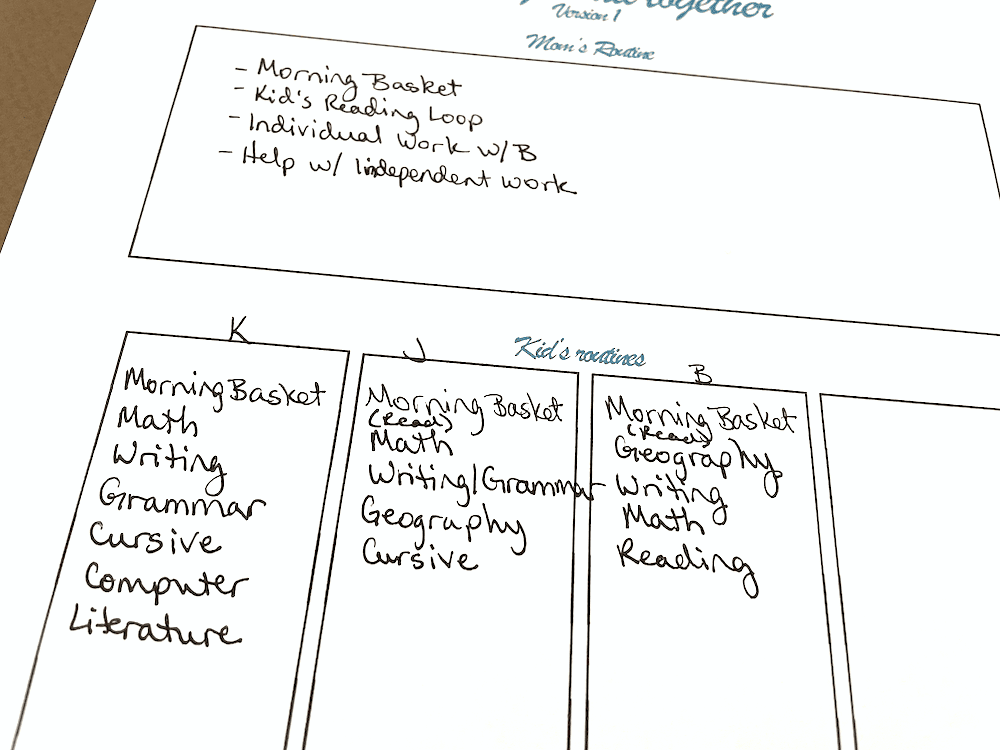
2. Create a routine
Creating a homeschool routine will give you some structure in your day to go by. A routine is generally regarded as a flow or order of things you do. Not a special procedure, but an ordinary list of everyday tasks. It is not generally associated with times.
This should not be stifling and should only be helpful for your family. In fact, it’s best if it flows from your natural rhythms and activities for your day. Yes, you will need to be mindful of adding certain things, but starting with your normal pace and flow will help your routines be successful.
Read: Use your Natural daily rhythm to make your schedule
Your daily routine homeschool schedule may be short and sweet, or it may be more detailed. Do what works for you.
A daily homeschool routine may look something like this:
- Morning Basket
- Individual read-aloud
- Individual work
Or it may be more detailed like this:
- Listen to hymn
- Read the history of the hymn
- History reading
- Science reading
- Science activities
- Individual read-aloud
- Work with B while others do independent work
- Help with independent work
Or you may focus more on the order of subjects done:
- Bible
- History
- Science
- Literature
- Math
- Writing
- Grammar
- Cursive
There is no right way to design your daily routine homeschool schedule, just do what works for you. Simply come up with an order of what to do. Write it down.
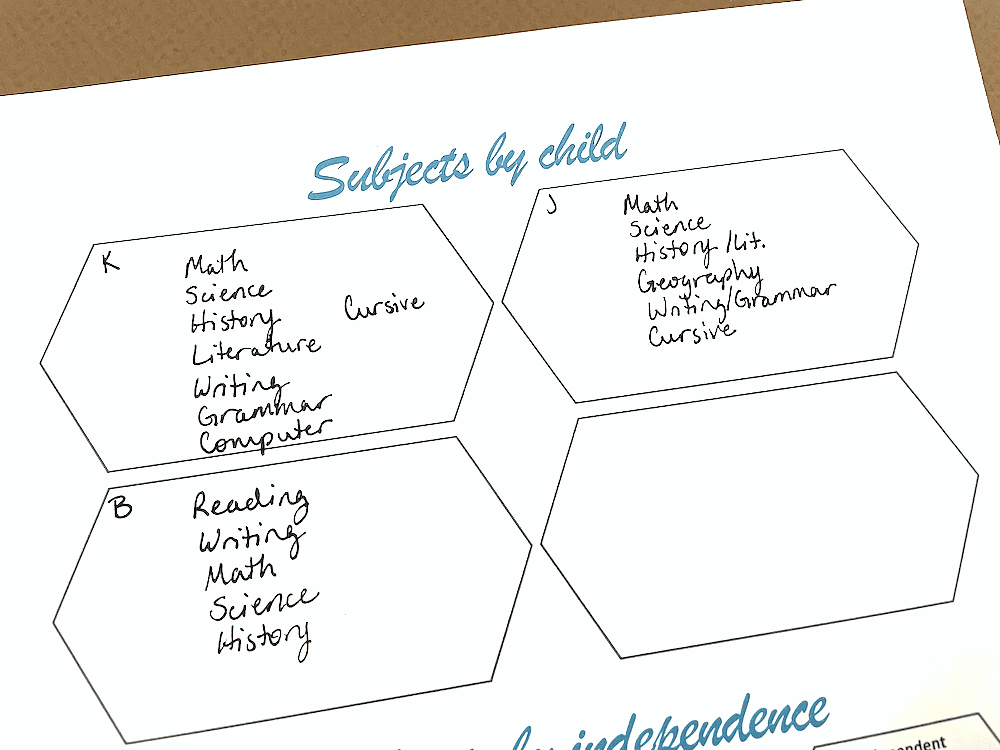
3. Choose a time
A homeschool routine is generally not bound by time within itself. But you will often accomplish this daily routine at a similar time each day. Making sure you have set aside a large amount of time with a general start time is important to completing your tasks regularly.
For instance, you may decide to start at 9 am and finish my 12 noon. But you won’t need to schedule each individual subject within the routine. You just decide on an order and go from one to the next to the next. That is a routine.
If you are making homeschooling your priority, you will choose a time that works in your daily schedule for your homeschool daily routine. Then you will plan other activities around that time.
You should not be fitting homeschooling into the extra space in your day after all other things. This is not making it a priority, as it should be.
So choose some time for your formal learning time. This is likely to be anywhere from 1-5 hours, depending on the age of your child and what you are including in this routine time.
Homeschooling will often include lots of play, activities, and field trips. Especially for young children. You can count this as part of your homeschool time or not.
Formal learning time is often considered bookwork time. Reading, crafts, writing, workbooks. The time that is often more parent-led. This time is often more limited in your day and should be highly influenced by your child’s attention span and abilities.
Early elementary kids will likely only need 1-2 hours of formal learning, while a high schooler will often read and write much more, requiring something more like 4-5 hours a day. Though older children will also be able to work more independently.
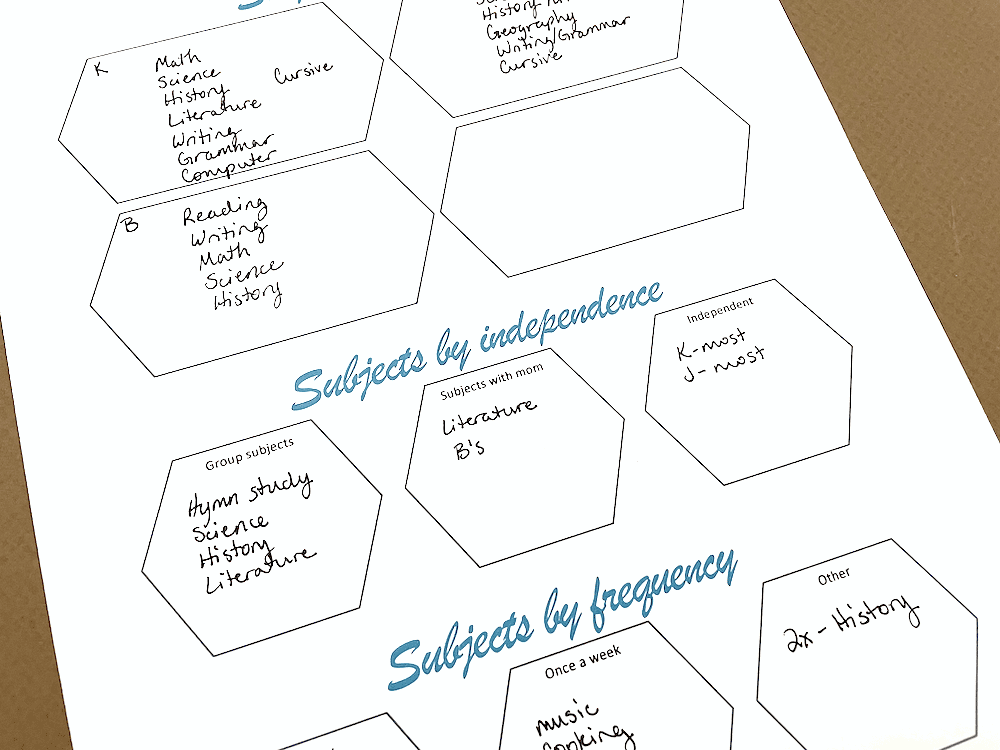
4. Together, individual, and independent
When setting up your daily routine homeschool schedule, you will need to consider what topics you want to cover together and what your kids will complete individually. Also, consider what your kids will work on independently. These will all affect how you set up your day.
Some subjects like math will naturally be easiest to have your kids do individually because they are based on progressive skill-building. While other subjects, like science and history, are more about just learning information and are perfect to do as a group. Some will call these content- or knowledge-based subjects.
If homeschooling multiple kids, doing as much as possible together will help simplify your day.
For the subjects you will not be doing together, you will still need to decide if your children will be doing them independently, or if they will need to do it with you. This is usually decided by your choice of curriculum and the age of your child.
All early elementary students will not be able to do much on their own. Also, some subjects like teaching your child how to read will need to be taught. Be sure to figure this into your daily homeschool routine.
There are also many curriculum options you will find that are very teacher-intensive no matter the age of the child. Many require a lot of prep and/or teaching. While others are designed for the student to do them independently. So consider this when choosing a curriculum.
Morning Basket
Having a Morning Basket is a wonderful way to have a group learning time in your homeschool. You may also have heard of a similar idea like Morning Time, Circle Time, or Morning Meeting. These are all generally the same idea where you gather all your kids together and learn.
You may read books, study a certain subject, and read poetry. Whatever you choose to include in your morning basket is a great way to simplify your homeschool a little by doing some subjects altogether.
It is also a wonderful way to include some of the subjects you may otherwise have a hard time including in your day.
For more thoughts and ideas about having a morning basket in your homeschool day, check out my post: Morning Basket Made Easy: Group Learning in Your Homeschool.
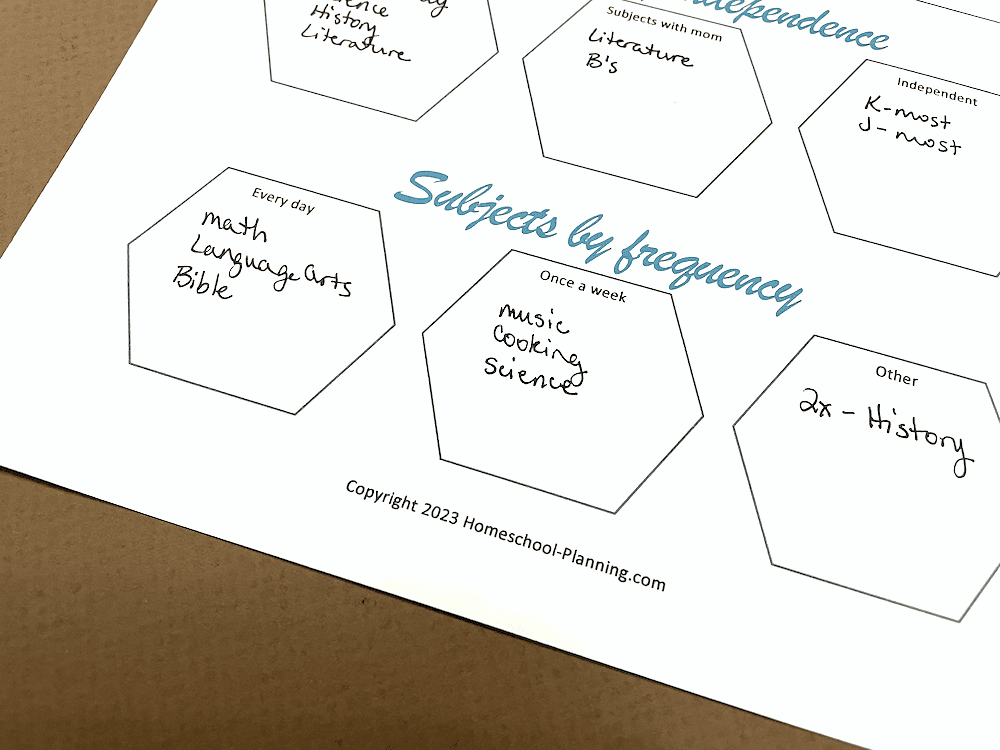
5. Consider the frequency
When thinking about your daily homeschool routine, you also need to think about how often you want to do each subject or task. This requires thinking beyond just your typical day.
Think about each subject you want to do, and how often you want to do it. Would you like to do that subject every day, only one time a week, twice a week, three times?
Do you have other things you need to work around in your week? Like a co-op or classes? Maybe you have homework from those to work in as well. Or you might like to leave one day free for field trips and errands.
You might want to do only one subject each day, alternating what you do. Or you may choose to do some subjects every day and alternate through others.
Skill-building subjects (math, writing) may work well to do every day, while knowledge-based subjects like science and history could easily be done less frequently.
You also can consider using some hacks like loop scheduling or block scheduling. More on those below, so keep reading!
There really is no right or wrong amount for any subject except what works for your family. But deciding on the frequency for each subject is necessary when developing your homeschool routines.

6. Decide on an order
A general order to your daily routine homeschool schedule will help you and your children know what to expect. Creating this predictable order is helpful for reducing stress and aids in setting good life skills later down the road.
You may decide an order for what your children do each day, or you may allow them to decide for themselves. Up to you.
If you have multiple kids, you may decide when you start and what you do together. Then leave the rest for your kids to work out after that.
This order can be flexible and general. Or strict and detailed if that works for you and your kids.
Should you eat the frog first?
There is a popular quote from Mark Twain that goes like this: “If it’s your job to eat a frog, it’s best to do it first thing in the morning. And If it’s your job to eat two frogs, it’s best to eat the biggest one first.”

It seems that he thought if you have something hard to do, get it over with first thing in the morning. And if you have more than one hard thing to do, do the more difficult thing first. This is good advice.
Then there is another side of the productivity fence that believes you should start your day with an easy, quick win. Something beautiful and enjoyable. This will give you motivation and a feeling of accomplishment that will lead you through your day by beginning on a high note.
So which is better? Should you eat a frog and begin your homeschool day with math? Or should you start with a short reading of poetry followed by a great read-aloud book?
I’ll leave that decision up to you. No matter what the experts say, there is no right way for everyone. Do what helps you and your children learn and function best. Keep in mind, it may be different for each child and each year!
Sometimes order matters
I have found the order I choose to do things matters for some things, and not for others. The things we do together are best to do first rather than doing individual work first. But the order that my kids do their individual work doesn’t really matter.
When I let my kids know it’s time to do school, it works best for us to get started on our group subjects, like history and literature. If we do individual subjects first, my kids will finish at different times. So one will get started on something else while they wait and I’ll have to pull them away from that to do the group subjects once the others are also finished.
So doing group things first works well for us at this point. But that may change.
Of course, as my kids get older and more independent, occasionally they have decided to get started on their individual work first thing in the morning before I am ready to start. That’s ok too.
I also like to do our group subjects, followed by the subjects I do with one child, then I am available for helping others. It works best for me this way.
But when it comes to what order my 6-year-old and I go through her subjects, that is up to her. It sometimes follows the same order out of habit, but other times she decides to change it up. Totally ok.
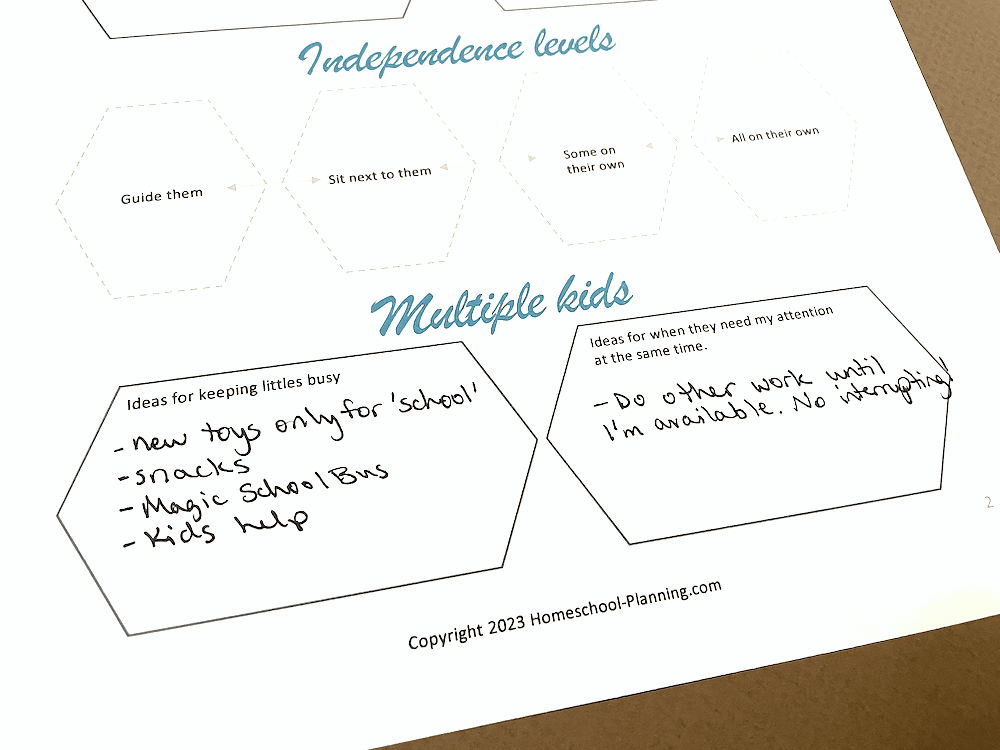
7. Managing multiple kids
Setting up a daily homeschool routine with multiple kids will require some extra planning. And it will look different for your unique needs and children. But it doesn’t have to take all day.
First off, be sure to make use of any subjects you can do as a family. Starting your day together will not only bring you together as a group but also help you accomplish more in a shorter amount of time.
There are many subjects that can be done (at least in part) together. From history to literature, to science, and many others. You can even do some together, then split up for related assignments at age level.
With several kids, you will also find it helpful to have a plan for what your kids will do with you and what they will do independently.
Encouraging independence will help you be able to rotate your time and attention with your children, allowing them to continue to work on something even when they aren’t with you. Of course, this will greatly depend on your child’s age and abilities.
If you have babies and toddlers, it is helpful to spend time with them first. Fill up that cup so you can then get time with the older kids. Your older kids can also take turns with the littles as part of their school. Yes, life skills are important for school.
When schooling several kids, you will need to be intentional with your time and communicate your expectations with your kids so they also know what to expect with the day.
Give yourself grace and try several things. You will eventually find your groove.
For more tips on homeschooling more than one, check out my post about homeschooling multiple ages.

8. Encourage independence
Encouraging independence in your homeschool will help you raise competent and confident learners. This is not something that should be rushed but should be done according to the ability of each individual child.
When they are young, you will be building the basic foundations of learning. Reading, writing, basic arithmetic. As they get older you will no longer need to be reading everything for them. Though reading aloud is valuable at any age – but that’s a topic for a separate article.
When working with young children, you will be doing everything with them, helping them all along the way. Keeping them on task, reading instructions, and explaining what they don’t understand.
With a little time and some of the basics under their belt, you may then be able to just sit with them while they work through some of their work. They may be able to read their own instructions, and you will just need to stand by to keep things moving and offer help.
Over more time, your child’s abilities will grow. Sitting with them every step of the way and looking over their shoulder may be more of a handicap than a help. If they have the ability, let them do things on their own.
Start with small amounts of time and increase to more. Be in the room for help as needed. Give instructions and allow them to follow through.
Of course, some curriculum is more hands-on than others, so you may end up teaching a topic and then allowing them to do a related project or activity alone. Allow them the independence to gain confidence and add their own personality and flavor to what they do.
Micromanaging your child’s work will lead to a lack of confidence in their abilities.
With multiple kids, allowing independence will also allow you to easily be able to work with each child as needed.
You can think of it like when your kids learned to walk. They started with watching you, then started trying a few steps while holding on to something. Then over time, they would take a few independent steps. Before long they can easily run.
The same can be applied to independence with their school work. Watching examples, then trying it with you next to them. Allow them to do some on their own, gradually increasing their ability to do it all independently.
Work yourself out of a job
When parenting, our ultimate goal is to raise humans that get to adulthood and are able to navigate this crazy world without us. We are working ourselves out of a job. The same is true for homeschooling.
If you aren’t teaching your children how to learn independently you are handicapping them for the rest of their lives. Help them learn how to learn. How to study and where to find information. How to manage their time and money.
You definitely will need to help your kids learn all along the way, but as they age, it’s good to start having them do things more and more on their own. They are apprenticing to be adults.

9. Looping
Looping is a helpful tool when it comes to your daily homeschool routine. When looping tasks, you will work down your list until you run out of time. The next day, you will start on the list where you left off, looping around to the beginning when the list is completed.
It is an easy way to get to everything on your list without taking all your time.
For instance, if you have 5 things you want to be sure to get to in your homeschool, but know you will only have an hour to do these things. Sometimes you might get through them all, while other times, you may only get to three.
Rather than starting over the next day and doing those same three things again and getting ahead on those, you can start with the last two items on your list. If you still have time, start back at number 1 until your time is over. Then loop through them again as you have time.
Remove the pressure of doing everything every day.
Or maybe you decide you want to do one thing each day. Like art, music, poetry, manners, and typing. You could assign each item to a different day of the week. But what happens if you go on a field trip two Fridays in a row? You will miss typing both weeks.
Instead, you could make it a loop list. Rather than assigning the tasks to days of the week, just decide you will do the next thing on the list the next day you have time. So then if you skip Friday, you will just move typing to Monday. Of course, other items will also then move a day, but that’s ok. Keep your schedule flexible.
You can easily loop the books you read, some school subjects, chores, your one-on-one time with your kids, and anything else you decide.
It’s such a great way to add some flexibility to your daily routine homeschool schedule!

10. Blocking
Blocking is another homeschool hack that will help you in your days. This is when you chunk your time into blocks to concentrate on one topic. This helps you to really dive deep into it during that time.
You might set aside one whole school day every week just for one subject rather than doing small portions of it each day. I have often done this with science. It helps me feel better about doing the messy experiments.
We can take our time and get into it and not worry about all the other things we also need to get done that day.
Or you might block one portion of your day, just for some extra subjects. Then loop the subjects within that time.
You might also want to block off a whole week and dive into a history unit. You can get through so much if that’s all you’re focusing on! It also can help you feed the interests of your children, diving deep into topics.

Practice and adjust
As you put your new homeschool routines into practice, you may notice things don’t go quite the way you expect. So work through your plans and adjust however you may find will help.
It can be helpful to ease into your new routines. You may start with only 1-2 items on your routine for a few days, slowly adding more tasks every few days. This can help you develop good habits without it being overwhelming.
Big changes all at once can easily just make you want to bail. So take it slow.
If something doesn’t work, make a small change here and there until you feel things are going smoothly. But be sure to try anything new for at least a week before you make any large adjustments. It can take time to get used to something new.
It can also be helpful when developing your routine to make it fairly natural. Don’t try to do a routine that is completely against your natural flow. For some ideas on how to make your routines more natural, check out my post about using your natural daily rhythm.
Printable daily routine homeschool schedule
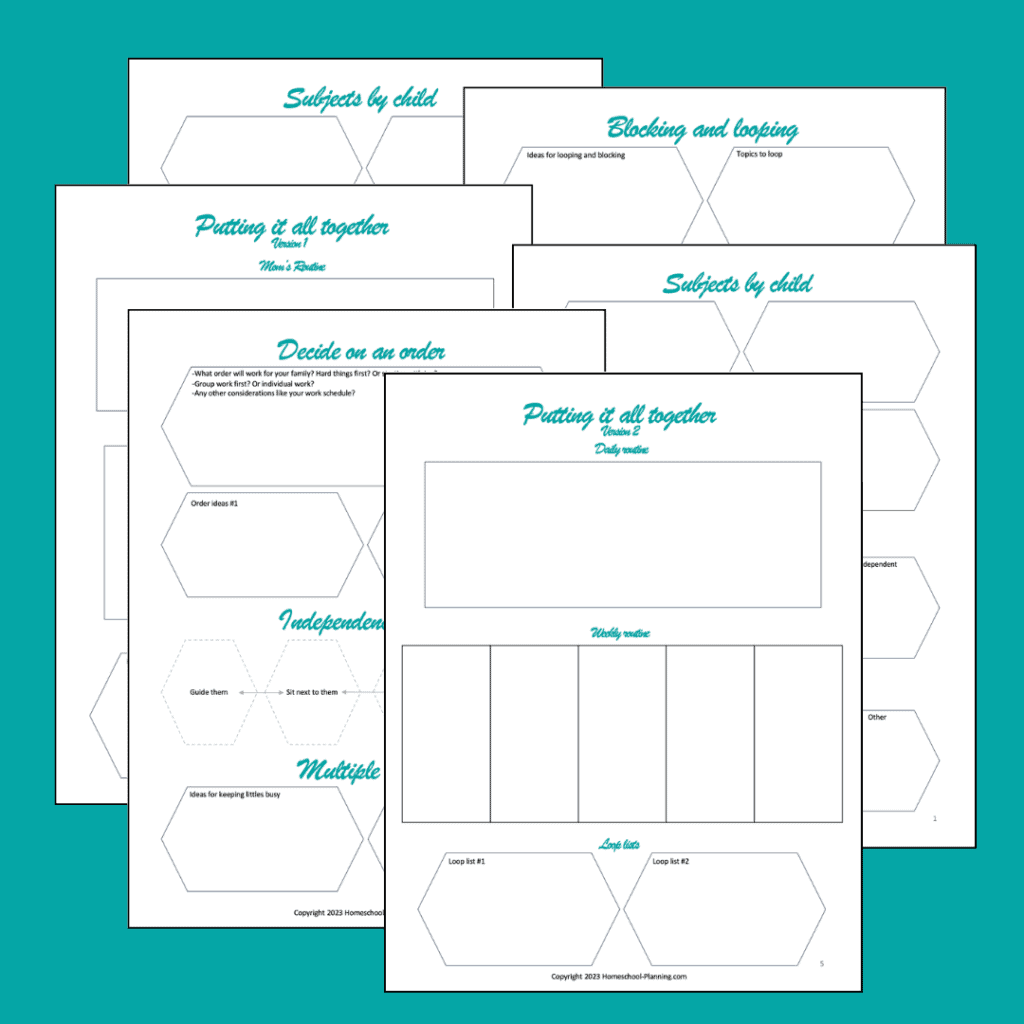
Looking for something easy to help you work through setting up your new daily homeschool routine? Download my FREE Printable daily routine homeschool schedule!
This worksheet set with 6 simple pages will walk you through the basic steps of laying out a custom routine for your family. There is space for several kids.
Take the guess work out of your daily routine with these free printable worksheets!
Design a daily routine homeschool schedule
Designing a daily routine homeschool schedule is one of the most important steps to making your homeschool days run smoothly. You take the books and ideas and figure out how to get through them each day.
Choosing your time, deciding on the order and frequency of each subject, to figuring out what you personally need to be involved with. There are many things to consider. But a daily homeschool routine will give you the confidence you need to tackle this homeschool thing!
Related posts
Choosing homeschool curriculum












